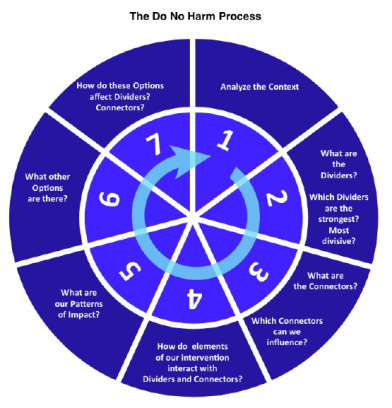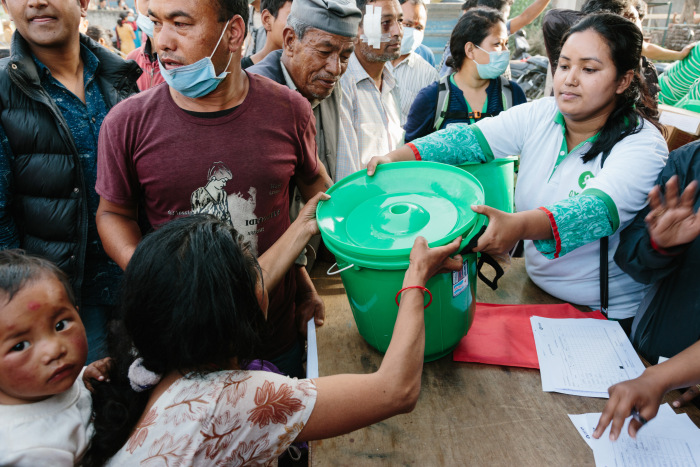The Do-No-Harm Approach: How to ensure that our work contributes to peace & not conflict
There is a fine line between harming and benefiting communities: Development agencies should be aware of the position or role they play in each context and acknowledge their own biases. The Do-No-Harm approach is the understanding of the impact of aid on existing conflict[1] & its interactions within a particular context, with the goal to limit or prevent unintended negative effects[2]. In the case of conflict, it focuses on the effectiveness of peace-building practices and helps aid workers understand the complexities of providing adapted assistance to civil societies and citizens in need. For example, the Conflict and Fragility unit of Oxfam works on building alliances between stakeholders such as CSOs, citizens and policy makers, with the goal to improve and create more inclusive policies. To ensure conflict is not inadvertently exacerbated by our actions, a deep analysis and understanding of the context we work in is required, which must be done by following the Do No Harm Process (DNH).

The DNH process requires undertaking several steps as shown in the diagram above:
Step 1 entails the analysis and understanding of specific aspects of the context: The identification of the area, of the population involved, actors in the conflict (government, ethnic groups etc.), root causes, existence of other interventions etc.
Step 2 to 4 involve the identification of connectors and dividers, as well as defining our projects’ implications and interactions with these two. Dividers and connectors (D&C) are the actions, institutions, values or experiences that divide people (sources of tension, mistrust, capacities for conflict) or connects them (source of trust, equality, capacities for peace). Identifying D&Cs is essential to avoid aggravating conflict. Improving and strengthening the connectors while taking the dividers into account increases the cooperation between local partners, which is vital to all development projects.
Step 5 is crucial as it defines the pattern of our impact, identifying the actions and their possible consequences that need to be considered when intervening in a fragile area. Our projects involve the transfer of resources, which has an impact on local communities. A positive impact can be easily diverted into a negative one, which may occur within the following 5 spheres: Theft, market, distribution, substitution and legitimization effects.
For example, a resource intended for distribution might be diverted for conflict purposes: In 2014, the South Sudanese army was seen wearing UNICEF backpacks that were intended for children (source). This story is a case of theft and legitimization effect: What started as a donation of school backpacks for children, became problematic when the backpacks were stolen by the army; it then appeared like UNICEF was legitimizing one of the groups causing violence in South Sudan.
However, aid agencies are in the power of countering these effects through the same patterns: For example, distributing locally produced resources would boost and stabilize local markets instead of threatening their competitiveness which happens when goods and services from outside are brought in.

Oxfam volunteers distributing hygiene kits in Nepal – Aubrey Wade / Oxfam
Following these steps allows international organizations to be more sensitive to the context they’re implementing projects in, and helps them explore more adapted strategies and policies, which brings us to the last two steps (6 & 7). It is important to conduct the D&Cs analysis once more, to ensure that the Do-No-Harm approach has been fully integrated into a project.
In terms of programming, it is vital to go through its critical details and to be able to have clear answers to the following questions: Who, Where, What, When, Why & How? Such as who is benefiting from the program, who are we hiring, who are our partners; where do we locate the office, where do we advertise; what inputs does our program imply; when is our intervention taking place, is it a post-conflict or post emergency context. ‘Why’ and ‘how’ questions are cross-cutting elements, for example questions like ‘Why that?’ or ‘How are we selecting staff’ can help examine the reasoning and the process of decision making.
The 4 days training covered all these steps and we were able to put our acquired knowledge into practice by working on case-studies based on real projects. Outlining the details of our projects using the DNH approach is crucial for understanding the impact they have on the context, knowing that “when an intervention of any kind enters a context, it becomes part of it”[3]. This is one of the main lessons learnt from this training, which will increase Oxfam Novib’s effectiveness and adaptivity to each context, as the do-no-harm approach is not limited to contexts of conflict and can be applied to all types of projects.
Growing up in Lebanon, a country that is caught up in the middle of political turmoil and conflict, I have always questioned the efficiency of humanitarian interventions, seeing no or small improvements in my home country, despite international organizations being very active in the region. I came to think that these organizations were misunderstanding the socio-political context of my country and the citizens’ needs. After participating to the ‘Conflict sensitivity’ training, I now understand the delicate importance of these programs and positive impact they could have if they adapt their strategies to the context.
[1] The definition of a conflict in this context is: A relationship between two or more parties (individuals or groups) who have, or think they have, incompatible goals, values, interests or claims to status, power or scarce resources.
[2] Source: Do No Harm DNH Participant Manual 2016
[3] Source: The Six Lessons for from the Do No Harm Project.
This blog was written by Windy Massabni, intern with the Conflict & Fragility team. Contact Windy on LinkedIn.




